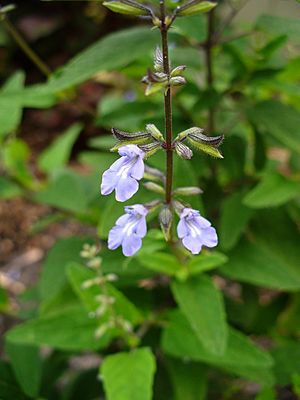Cayman sage facts for kids
Quick facts for kids Cayman sage |
|
|---|---|
 |
|
| Conservation status | |
| Scientific classification |
Salvia caymanensis, also known as the Cayman sage, is a special plant found only on Grand Cayman in the Cayman Islands. It's a type of Salvia plant that doesn't live for many years. For almost 40 years, people thought this plant had completely disappeared. But then, in 2007, it was found again!
After a big storm called Hurricane Ivan hit in 2004, experts thought the conditions might be just right for the Cayman sage to grow again, if its seeds were still in the ground. They even put out a "wanted poster" offering a reward of 1000 CI$ to anyone who could find the plant. This led to the amazing discovery of the first plants seen since 1967.
What Does It Look Like?
The Cayman sage usually grows to be about 50 to 100 centimeters (20 to 39 inches) tall. Its stem stands straight up. The top part of the stem is covered in fine, soft hairs, and the bottom part is woody.
The leaves are shaped like an oval with a pointed tip. They are about 2.5 to 3 centimeters (1 to 1.2 inches) long and 1 to 1.4 centimeters (0.4 to 0.5 inches) wide. The underside of the leaves is pale and covered in soft, woolly hairs. The top side is dark green and also has fine hairs. The leaf stems are about a quarter the length of the leaf blade.
How It Was Found Again
In the spring of 2007, the Department of Environment in the Cayman Islands worked with the Darwin Initiative to find the missing Cayman sage. They put up "wanted posters" all over the island. These posters offered a reward of 1000 CI$ for anyone who could find a living Cayman sage plant. They put the posters out just before the time of year when the plant usually blooms.
An island resident was driving slowly because of road work on Queen's Highway. As she drove, she noticed some small blue flowers growing by the side of the road. These were the hard-to-spot flowers of the Cayman sage! After this first discovery, about 300 individual plants were found. Experts were also able to collect around 18,000 seeds from these plants. This was a huge success for conservation efforts!
See also
 In Spanish: Salvia caymanensis para niños
In Spanish: Salvia caymanensis para niños


